Granite Falls Manufacturing Aluminum Soprano D
Posted: Sun Apr 16, 2006 8:40 pm
Review housed at http://www.tinwhistler.com/reviews.asp
Preface
I've been writing back and forth with Chuck since 2004, when he told me he was interested in making whistles. A couple of people probably write to me a year and tell me something similar, so I'm really pleased to see that not only has Chuck fulfilled his goal, but also that the instruments he makes are top notch performers. His debut into the whistle-making world was a lightweight brass design which he quickly scrapped for a higher quality instrument in aluminum. I had one of his earlier prototypes which I liked a lot, but he asked for it back after making some design changes (such as the double-o-ring tuning slide). Chuck recently offered to send me his latest design, and I naturally jumped at the chance.
At a Glance
Whistle Reviewed: Granite Falls Manufacturing Aluminum Soprano D
Models Available: Aluminum whistles in keys of E, D, C, and B-flat
Construction: Aluminum with aluminum fipple
Price at time of review: $74.50 US + $29.85 for each additional body.
Available From: Granite Falls Manufacturing
How Acquired: Product Sample from Manufacturer
Appearance/Construction
The whistle is all aluminum except for the o-rings in the tuning slide, and has a nice brushed aluminum finish. It's a bit utilitarian in look, kind of like an Overton or Chieftain, with all of the bang-for-the-buck going toward quality rather than snazzing up the design--and that's just fine by me.
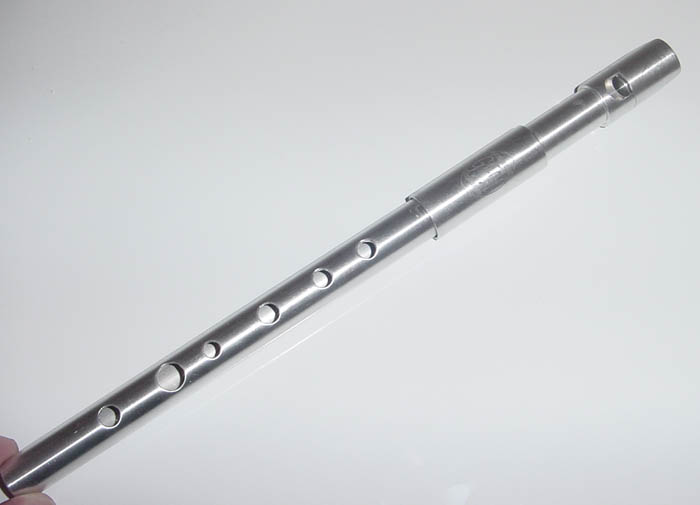
Here's the full whistle. There's not a lot I can say here that I haven't already. Straight lines, steady workmanship. It's not fancy, but it doesn't have to be. Bear in mind that I'm not a professional photographer, and my digital camera seems to pick up a lot more "scratches" on aluminum whistles than I can see with my naked eye, so this whistle's not as beat up as the pictures make it look!
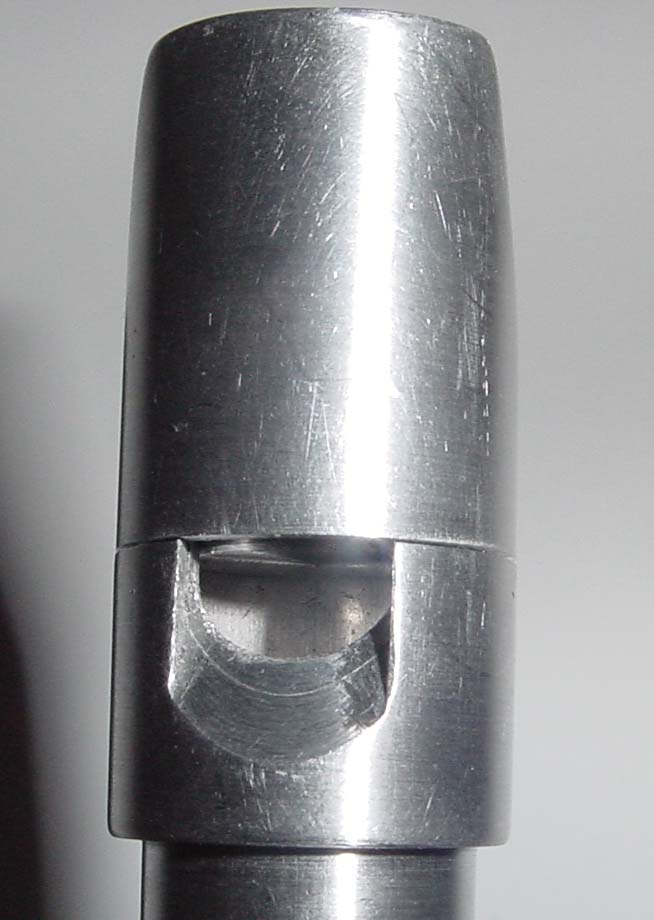
Here's a close-up of the mouthpiece. The angled blade reminds me of a Kerry Songbird low D, or an Alba. It produces a lot purer sound than either of those two instruments, however.
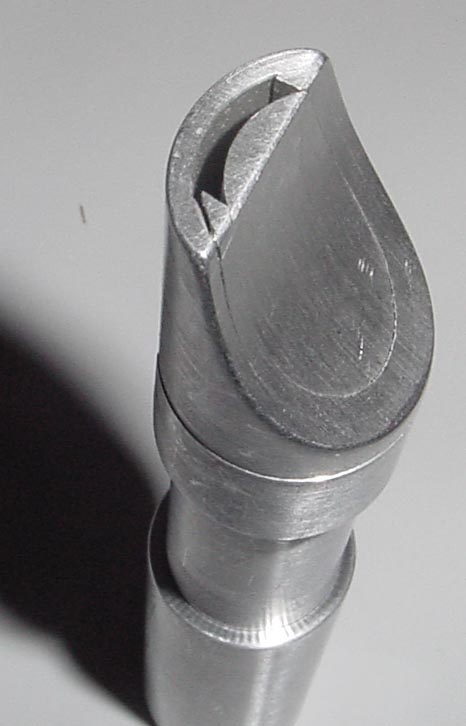
Here's another angle on the mouthpiece, showing the fipple area. That little gap on the left of the windway/fipple join is the only real defect I found in the whistle. It's cosmetic only, and doesn't affect the playability at all. And since nobody but the player will ever see it, I easily put this in the category of "who cares?". Well, except for that one time a beard hair got plucked out by it..then I cared a bit more!
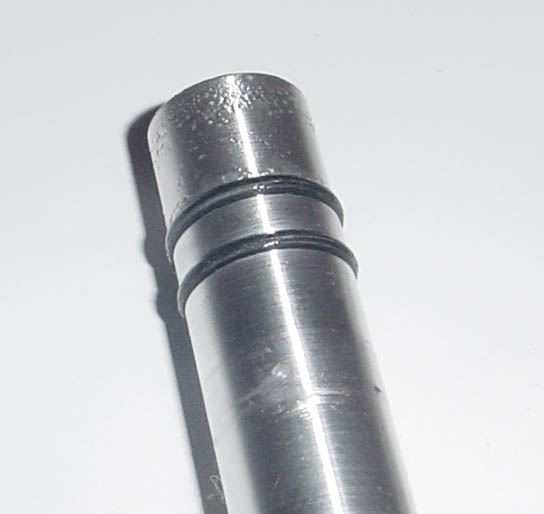
Here's the tuning slide, with a little cork grease on it. The double o-ring construction means the slide holds nicely, and also doesn't wobble. You'll definitely want to keep the o-rings a little lubricated though, so that they don't wear out prematurely.
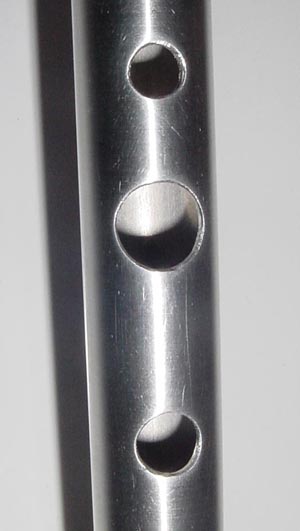
A shot at the end of the whistle, showing the last three holes. This whistle has the F# hole a little close to the E hole--many whistles share the same configuration. Unlike the prior brass version, these holes aren't so close that my fingers collide while playing. No issues here.
Playing Characteristics
The GFM Aluminum Soprano D has a very pure and strong tone. There's really no chiff to speak of within the note itself, and only the barest hint at the start of a note. The whistle becomes a little unruly in the 2nd octave when moist, but otherwise plays very cleanly.
Sound clips of the whistle:
Calliope House. You can hear a bit of the squeaking due to the whistle being moist when I made this recording. When dry, the whistle plays a bit cleaner.
Volume: Loud--easily compares to a Susato or Sweetheart. This falls into that range of instruments that start becoming a bit uncomfortable to play in front of my computer, which is right up against a wall. There's too much sound bouncing back at me! But that makes it perfect for the louder venues I play at, as well as outdoors play.
Responsiveness: Fast. I didn't have any issues with this whistle playing up to speed.
Tuning: In tune across it's range once you get used to the breathing requirements. Most whistles need a little push on F# to bring it into tune, but this whistle actually needs you to pull back just a hair...so if you've got a fair amount of whistle experience, you may blow F# a bit sharp when you first pick this up. The tuning slide works well, and has a lot of play. All the way in, and my tuner calls A a perfect Bb. All the way out, and I sound a perfect G#. If you have to tune more than that, tell the accordion player to send his instrument in for a tune up!
C-natural: OXXOOO produces a good in-tune C-natural that is a little easier to push sharp than drop flat. OXXOXX produces a C-natural that you have to push just a little, and is easier to drop flat than go sharp. So take your pick depending on where you're going with the tune.
Hole size and placement: The holes show extremely minor signs of being worked, but aren't at all ragged or bad looking. They are centered on the whistle, and round. Pretty average spacing, with the F# hole being a little close to the E hole, as on many whistles. Unlike his prior brass version that I reviewed, Chuck has spread these out enough, and my fingers no longer trip each other up on these notes.
Air volume requirements: Slightly above average. Not so much as you might notice on a quick toot, but over the course of a tune, I find myself breathing more often.
Air pressure requirements: Standard, with a bit of aggression required in the second octave.
Clogging: The whistle never gave out on me, but after getting wet, it did get a bit unruly in the 2nd octave. Being aluminum, I'd rather Duponol the windway, rather than flicking the moisture out every couple of tunes.
Wind Resistance: Moderate. The first time I played this whistle this outside, a slight breeze across the windway cut it out. But then I played it a few more times, and found that for most wind angles, this whistle worked pretty good. But there is a narrow angle where the wind will cut this whistle out without effort, so it's best if you don't play in a cross-wind.
Summary
Nice looking and nice sounding whistle. Good overall playability and execution, with a rugged construction. This would probably be among my first choices for a Renaissance Faire whistle or playing a pub or parade on St Patrick's Day.
Preface
I've been writing back and forth with Chuck since 2004, when he told me he was interested in making whistles. A couple of people probably write to me a year and tell me something similar, so I'm really pleased to see that not only has Chuck fulfilled his goal, but also that the instruments he makes are top notch performers. His debut into the whistle-making world was a lightweight brass design which he quickly scrapped for a higher quality instrument in aluminum. I had one of his earlier prototypes which I liked a lot, but he asked for it back after making some design changes (such as the double-o-ring tuning slide). Chuck recently offered to send me his latest design, and I naturally jumped at the chance.
At a Glance
Whistle Reviewed: Granite Falls Manufacturing Aluminum Soprano D
Models Available: Aluminum whistles in keys of E, D, C, and B-flat
Construction: Aluminum with aluminum fipple
Price at time of review: $74.50 US + $29.85 for each additional body.
Available From: Granite Falls Manufacturing
How Acquired: Product Sample from Manufacturer
Appearance/Construction
The whistle is all aluminum except for the o-rings in the tuning slide, and has a nice brushed aluminum finish. It's a bit utilitarian in look, kind of like an Overton or Chieftain, with all of the bang-for-the-buck going toward quality rather than snazzing up the design--and that's just fine by me.

Here's the full whistle. There's not a lot I can say here that I haven't already. Straight lines, steady workmanship. It's not fancy, but it doesn't have to be. Bear in mind that I'm not a professional photographer, and my digital camera seems to pick up a lot more "scratches" on aluminum whistles than I can see with my naked eye, so this whistle's not as beat up as the pictures make it look!

Here's a close-up of the mouthpiece. The angled blade reminds me of a Kerry Songbird low D, or an Alba. It produces a lot purer sound than either of those two instruments, however.

Here's another angle on the mouthpiece, showing the fipple area. That little gap on the left of the windway/fipple join is the only real defect I found in the whistle. It's cosmetic only, and doesn't affect the playability at all. And since nobody but the player will ever see it, I easily put this in the category of "who cares?". Well, except for that one time a beard hair got plucked out by it..then I cared a bit more!

Here's the tuning slide, with a little cork grease on it. The double o-ring construction means the slide holds nicely, and also doesn't wobble. You'll definitely want to keep the o-rings a little lubricated though, so that they don't wear out prematurely.

A shot at the end of the whistle, showing the last three holes. This whistle has the F# hole a little close to the E hole--many whistles share the same configuration. Unlike the prior brass version, these holes aren't so close that my fingers collide while playing. No issues here.
Playing Characteristics
The GFM Aluminum Soprano D has a very pure and strong tone. There's really no chiff to speak of within the note itself, and only the barest hint at the start of a note. The whistle becomes a little unruly in the 2nd octave when moist, but otherwise plays very cleanly.
Sound clips of the whistle:
Calliope House. You can hear a bit of the squeaking due to the whistle being moist when I made this recording. When dry, the whistle plays a bit cleaner.
Volume: Loud--easily compares to a Susato or Sweetheart. This falls into that range of instruments that start becoming a bit uncomfortable to play in front of my computer, which is right up against a wall. There's too much sound bouncing back at me! But that makes it perfect for the louder venues I play at, as well as outdoors play.
Responsiveness: Fast. I didn't have any issues with this whistle playing up to speed.
Tuning: In tune across it's range once you get used to the breathing requirements. Most whistles need a little push on F# to bring it into tune, but this whistle actually needs you to pull back just a hair...so if you've got a fair amount of whistle experience, you may blow F# a bit sharp when you first pick this up. The tuning slide works well, and has a lot of play. All the way in, and my tuner calls A a perfect Bb. All the way out, and I sound a perfect G#. If you have to tune more than that, tell the accordion player to send his instrument in for a tune up!
C-natural: OXXOOO produces a good in-tune C-natural that is a little easier to push sharp than drop flat. OXXOXX produces a C-natural that you have to push just a little, and is easier to drop flat than go sharp. So take your pick depending on where you're going with the tune.
Hole size and placement: The holes show extremely minor signs of being worked, but aren't at all ragged or bad looking. They are centered on the whistle, and round. Pretty average spacing, with the F# hole being a little close to the E hole, as on many whistles. Unlike his prior brass version that I reviewed, Chuck has spread these out enough, and my fingers no longer trip each other up on these notes.
Air volume requirements: Slightly above average. Not so much as you might notice on a quick toot, but over the course of a tune, I find myself breathing more often.
Air pressure requirements: Standard, with a bit of aggression required in the second octave.
Clogging: The whistle never gave out on me, but after getting wet, it did get a bit unruly in the 2nd octave. Being aluminum, I'd rather Duponol the windway, rather than flicking the moisture out every couple of tunes.
Wind Resistance: Moderate. The first time I played this whistle this outside, a slight breeze across the windway cut it out. But then I played it a few more times, and found that for most wind angles, this whistle worked pretty good. But there is a narrow angle where the wind will cut this whistle out without effort, so it's best if you don't play in a cross-wind.
Summary
Nice looking and nice sounding whistle. Good overall playability and execution, with a rugged construction. This would probably be among my first choices for a Renaissance Faire whistle or playing a pub or parade on St Patrick's Day.